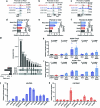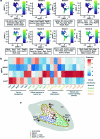Spatial enhancer activation influences inhibitory neuron identity during mouse embryonic development
- PMID: 38528203
- PMCID: PMC11088997
- DOI: 10.1038/s41593-024-01611-9
Spatial enhancer activation influences inhibitory neuron identity during mouse embryonic development
Abstract
The mammalian telencephalon contains distinct GABAergic projection neuron and interneuron types, originating in the germinal zone of the embryonic basal ganglia. How genetic information in the germinal zone determines cell types is unclear. Here we use a combination of in vivo CRISPR perturbation, lineage tracing and ChIP-sequencing analyses and show that the transcription factor MEIS2 favors the development of projection neurons by binding enhancer regions in projection-neuron-specific genes during mouse embryonic development. MEIS2 requires the presence of the homeodomain transcription factor DLX5 to direct its functional activity toward the appropriate binding sites. In interneuron precursors, the transcription factor LHX6 represses the MEIS2-DLX5-dependent activation of projection-neuron-specific enhancers. Mutations of Meis2 result in decreased activation of regulatory enhancers, affecting GABAergic differentiation. We propose a differential binding model where the binding of transcription factors at cis-regulatory elements determines differential gene expression programs regulating cell fate specification in the mouse ganglionic eminence.
© 2024. The Author(s).
Conflict of interest statement
The authors declare no competing interests.
Figures
















References
-
- Bandler RC, Mayer C. Deciphering inhibitory neuron development: the paths to diversity. Curr. Opin. Neurobiol. 2023;79:102691. - PubMed
Publication types
MeSH terms
Substances
Grants and funding
- ERC-2018-STG/EC | EU Framework Programme for Research and Innovation H2020 | H2020 Priority Excellent Science | H2020 European Research Council (H2020 Excellent Science - European Research Council)
- 803984/EC | EU Framework Programme for Research and Innovation H2020 | H2020 Priority Excellent Science | H2020 European Research Council (H2020 Excellent Science - European Research Council)
- 01EW1605/EC | EU Framework Programme for Research and Innovation H2020 | H2020 Priority Excellent Science | H2020 European Research Council (H2020 Excellent Science - European Research Council)
LinkOut - more resources
Full Text Sources
Molecular Biology Databases
Research Materials

